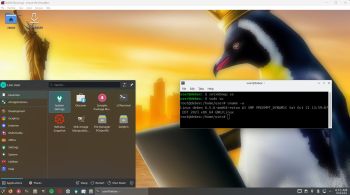 Description
Description
Exton|Defender SRS is a Linux system available as a Live DVD based on Fedora Rawhide, 64bit. (Rawhide is the development version of Fedora). Exton|Defender is for administrating or repairing your system and data after a crash. Exton|Defender aims to provide an easy way to carry out admin tasks on your computer, such as creating and editing the hard disk partitions. It comes with a lot of Linux software such as system tools and basic tools (editors, Midnight Commander, network tools). Exton|Defender can, however, also be used as a normal Linux Desktop System. It requires no hard drive installation, but can easily be installed to hard drive if you want. Desktop environments: Special versions of Deepin and Cinnamon developed by Fedora.
231111: HAVE I GOT NEWS FOR YOU!
Today I discovered (by chance) that you can install Exton|Defender Build 231109 to a USB stick with persistence! I.e. all your system changes will be saved directly on the USB stick. Even big system upgrades! That will make it unnecessary to install Exton|Defender to hard drive (which can be a bit tricky). Just run the System from a big enough USB stick and be happy! Do it like this:
1. Use Rufus 4.3 for the installation.
2. Set a Persistent partition size of about 3GB before you start the installation. Watch this screenshot…
3. Run Exton|Defender from your created USB stick. Be sure boot up the System in Legacy mode. You can run the System also in UEFI mode, but unfortunately persistence won’t be enabled then.
4. Test run Exton|Defender and change some things. For example new bookmarks in Firefox. Reboot!
5. You changes should be left if you have done what I said above. Now you can upgrade the whole system with “sudo dnf upgrade –refresh”. About 230 packages can be upgraded as of 231111. Watch this screenshot…
6. Finally you can make a new ISO (your own) if you want. Be sure to change /etc/refractasnapshot.conf first. You must see to that the new ISO file and the work environment will be created on another partition. Watch this screenshot…
7. Start Refractasnapshot in a terminal with the command “sudo /usr/bin/refractasnapshot”. Follow the instructions. After a few minutes your ISO will be ready. Watch this screenshot…
NEWS 231109 ABOUT Exton|Defender Rawhide (Fedora 39/40)
I’ve made a new version of Exton|Defender 64 bit based on Fedora “Rawhide” (the development version of Fedora). I.e. upcoming Fedora 39/40. This new version uses the Cinnamon and Deepin Desktops. Log in to the Desktop environment you prefer. Study all other installed packages.
MOST IMPORTANT CHANGE: I’ve finally managed to install Refracta Snapshot in Exton|Defender, which means that you can create your own Fedora Rawhide System! I mean change everything to your liking and then create a new ISO.
NOTE1: For Refracta Snapshot to work you have to run “my” kernel 6.5.3-amd64-exton when Refracta Snapshot is running. (It won’t work with Fedora’s kernel 6.7).
NOTE2: Version 231109 of Exton|Defender can run on really old computers. As an example I could run it on my 17 years old laptop Acer Aspire 5102 WLMi.
THE IMPORTANCE OF Exton|Defender being based on upcoming fc 39/40
Programs won’t “crash” or anything like that. And I haven’t noticed any “bugs”. That said you should of course be a bit careful. This version of Exton|Defender is for people who like to use “cutting-edge” software and the latest kernels etc. You will always have the latest Linux/Fedora software installed if you regularly run the command sudo dnf upgrade ‐‐refresh.
SCREENSHOTS
Screenshot 1 – Exton|Defender – running in full screen in VirtualBox
Screenshot 2 – Anaconda (Fedora’s Installer) has started
Screenshot 3 – Refracta Installer has started
Screenshot 4 – Deepin DE is used
Screenshot 5 – Refracta Snapshot has started
READ MORE…
Android-x86 Custom

Read about my Android-x86 Systems 11, 10, Pie, Oreo, Nougat, Marshmallow, Lollipop and KitKat at
andex.exton.net latest is AndEX 11 (with GAPPS), AndEX 10 (with GAPPS) and AndEX Pie 9.0 (also with GAPPS)!
and
about my Android 13, 12, 11, 10, Pie, Oreo, Nougat, Marshmallow and Lollipop versions for Raspberry Pi 4 and 3/2 at
raspex.exton.se latest is RaspAnd 13 and 12 (without GAPPS), RaspAnd 11 (with GAPPS) and RaspAnd Oreo 8.1 (also with GAPPS)!
|
 NEWS ABOUT SlackEX BUILD 231129 with the Xfce4 DESKTOP (DE)
NEWS ABOUT SlackEX BUILD 231129 with the Xfce4 DESKTOP (DE)












